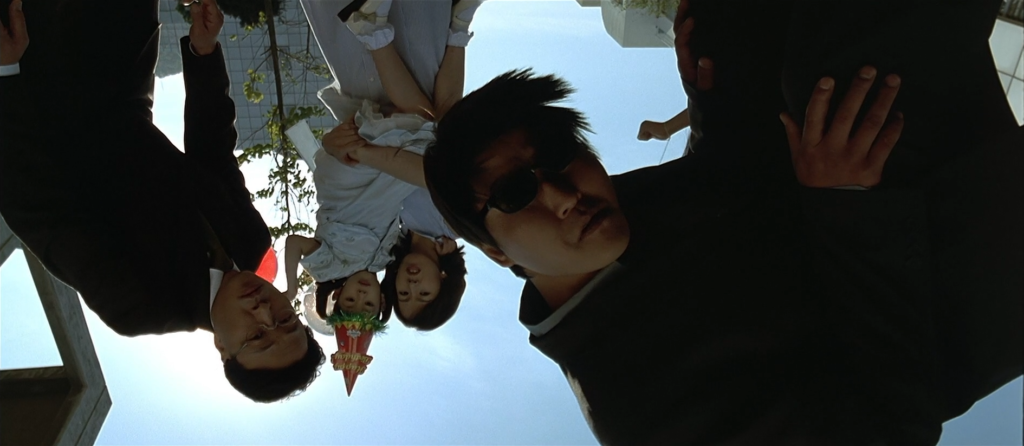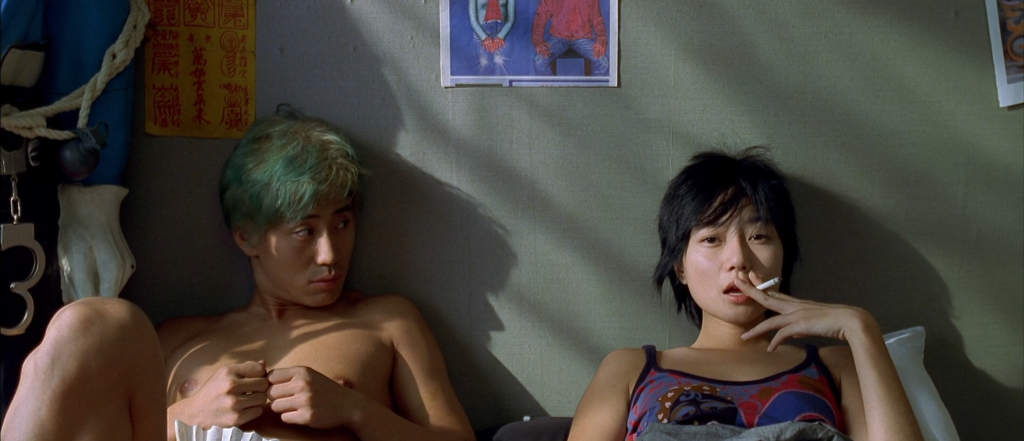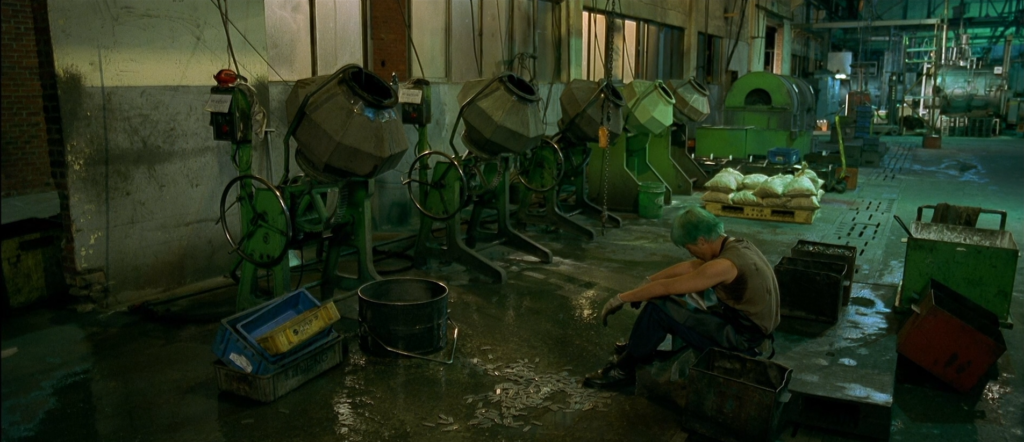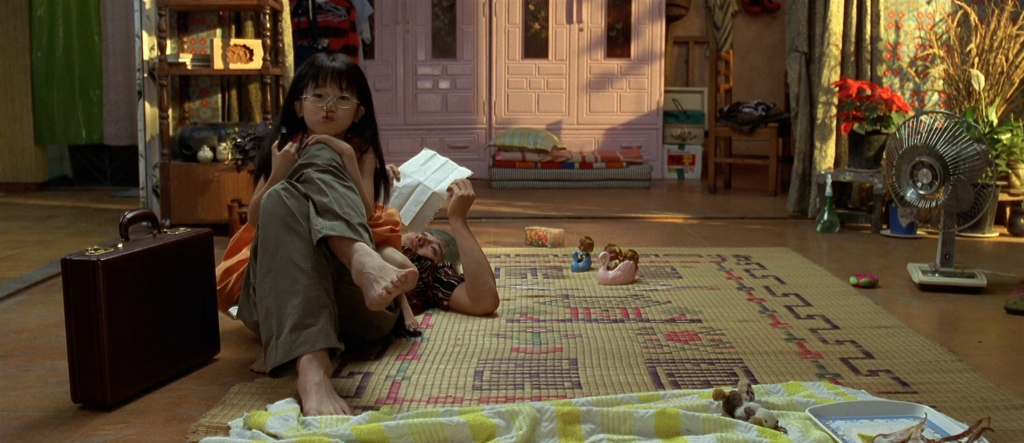| Luke Mosher |

Sympathy for Mr. Vengeance plays at the Trylon Cinema from Friday, June 30 through Sunday, July 2. Visit trylon.org for tickets and more information.
This summer, one of Trylon’s flagship series is a collection of revenge movies called A Dish Best Served Cold. No series on revenge would be complete without a film from Park Chan-wook’s Vengeance Trilogy, Sympathy for Mr. Vengeance (2002), Oldboy (2003), and Lady Vengeance (2005)—three unrelated films connected by the theme of revenge. The obvious pick from this trio might be the fan favorite Oldboy, which famously catapulted the director to the center of international fame when it played the Cannes Film Festival and won the second-place prize, the Grand Prix. Oldboy remains Park’s most iconic film, and is perhaps the single-most famous movie from South Korea besides Parasite (2019), which took the world by storm a few years ago. However, I was delighted to learn that Trylon had selected Sympathy for Mr. Vengeance, which is, dare I say it, the strongest film of the trio, and Park’s best movie. The genre-defying film is a mix of Kurosawa’s High and Low (1963) and the Coen brothers’ Fargo (1996), a darkly comedic crime caper that turns into a profoundly moving meditation on vengeance and justice, and whether the difference between the two may only be a matter of perspective.
Normally, I’d talk a little about the plot, but I think the story of Sympathy for Mr. Vengeance is too good to be revealed, so I will do my best to keep the many twists and turns under lock and key, as not knowing where the movie is going next is one of its many pleasures. The one-sentence plot synopsis that reveals no more than what’s on Trylon’s programming guide is this: a deaf man named Ryu (Shin Ha-kyun), caring for an ailing sister (Ji-Eun Lim) in need of a kidney transplant, attempts to secure money for a life-saving operation by extracting money from his boss Dong-jin Park (Song Kang-ho) by kidnapping his daughter (Han Bo-bae). I will try to talk as little as possible about what happens next, but I can tell you that it involves my favorite plot development: things go wrong. In a revenge film, how else could they go?

Sympathy for Mr. Vengeance is Park Chan-wook’s fourth film. Park’s breakout picture was the one just before it, his third, Joint Security Area (2000; also called JSA), based off the novel DMZ by Park Sang-yeon. It’s worth talking about JSA just a bit to give some context for Sympathy for Mr. Vengeance. JSA is a police procedural about an investigation into a violent incident between border guards of North and South Korea in the Korean Demilitarized Zone, which is told in flashback. The film was a hit because itcame outat exactly the right time for the filmgoing public, who was especially interested in relations between North and South Korea. Three months before JSA’s release, there was a summit between the two countries, the first positive meeting between them since the Korean War five decades earlier1. Though peace was ultimately not to be resolved between the two nations, many at the time were hopeful it would be.
Some critics, like film scholar Steve Choe, have made a good case that JSA was a template for what Park was really up to in the Vengeance Trilogy, which can be read as a broad metaphor of the history of violence between North and South Korea2. Political violence between the two countries is text in JSA, and in the Vengeance Trilogy, it remains as subtext. In an interview for Lady Vengeance, Park said, “vengeance is essential—is at the core not just in Korean society, but in all societies. I believe that vengeance defines twenty-first-century Korea, but that vengeance stories are a central metaphor for life anywhere.”3 In Park’s movies, vengeance leads to destruction, and his characters follow its twisted logic to its bitter end. By showing the destructive effects of the endless cycles of violence, these films are actually a reductio ad absurdum argument for peace and even forgiveness for one’s enemies, be it an entire country, or the guy who personally wronged you.

The real brilliance of Sympathy for Mr. Vengeance is that it is a moral drama disguised as a genre movie. The film’s pulpy title suggests we’re in for a bit of the old ultra violence, and while the film is about as violent as they come,4 it doesn’t revel in it the way a normal genre move would. We‘re hooked by the promise of vengeance, but what the movie delivers is much more unconventional and much more profound: sympathy. The film achieves this in part through a strong social consciousness, with pointed scenes showing the main character Ryu at his wearisome factory job (other workers need hearing protection but he doesn‘t bother because he‘s deaf—a nice touch that shows a character both clever and tired) and troubled navigation of the South Korean hospital system. Likewise, his deafness is, rather respectfully for a movie that doesn’t shy away from cruelty, never presented as a disability.5 Ryu’s boss Dong-jin is set up as an antagonist—called a bourgeois capitalist by Ryu‘s socialist girlfriend Yeong-mi Cha (Bae Doona)—but the film eventually humanizes him, and we even come to care for him. We learn that his wife left him during the country’s economic depression of the late 1990s, and he has had to make financial sacrifices to keep his company running. His kidnapped daughter is all he has left, and to lose her would be to lose everything. Ryu and Dong-jin are two opposing characters, each facing a moral dilemma that seems impossible to resolve and each feeling they deserve revenge against the other, which looks like justice in their own eyes. Through a radical perspective shift that’s like a narrative magic trick, we ultimately sympathize with both of them equally, like a coin perfectly balanced on its edge that doesn’t know which way to fall.
Park Chan-wook is one of the most stylistically inventive directors of the modern era, and has found international success in part because his creative visual storytelling translates well to foreign audiences. Mr. Vengeance is a bit of an outlier in his filmography because of his (relative) restraint, especially compared to the hyper-stylized punch in the face that Oldboy would be to audiences just a year later. Park says, “I wanted to create a simple and natural beauty…a minimalist film.”6 A minimalist film, but by a maximalist director. Park Chan-wook never met a camera trick he didn’t like. If the film is in any way minimalist, it’s in its sparce dialogue and slow pace. But in every other way the film is stuffed with wonderfully creative visual choices, many of which are darkly funny. Park’s style is defined by his precision, and his films feel immaculately planned and perfectly executed, almost to a fault. Mr. Vengeance, by contrast, is grounded and naturalistic but still feels artfully composed, like the watercolor landscapes that Ryu paints on postcards in the movie.

Mr. Vengeance has some fun filmmaking elements that are worth mentioning. Park says he wrote the first draft in a marathon session of 20 hours,7 which is incredible not simply for its speedy completion, but because the film has one of the all-time great clockwork scripts, where each detail has a reason for being there and pays off later. It was shot on Super 35 with wide-angle anamorphic lenses,8 creating an exceptionally wide frame and clear depth of field, which allowed for striking visual composition and mise-en-scène. Park wanted the characters to feel isolated on screen, and the widescreen format makes them look lost in their environments. The film also has an unusual green motif, which Park colorfully calls “puke green,” most prominently illustrated by Ryu’s dyed hair—an expression of his one-time dream to be an artist. There is also lots of green lighting, which we see in interiors like Ryu’s factory job and exteriors like the neon lights of the city, which play up the artificiality of the urban environments, contrasting well with the green of the mountains that surround the city of Seoul, where the film is set.
As I promised at the beginning of this article, I have only hinted at the story of Sympathy for Mr. Vengeance so that you can discover it on your own. Let me leave you with a few more words from Park Chan-wook that help explain what it all means. “Revenge is an endless circle of evil, going around and around until the chain breaks. We tend to justify vengeance, but it’s not my idea to justify it or explain it. My idea in this film is to take this vengeance, right or wrong, unjust or foolish, and to get the audience to feel it, to taste it.”9 Few films taste as bitter as Sympathy for Mr. Vengeance, or are as told as beautifully. It is not an easy film to watch, but it is an easy film to love.
Footnotes
- Paquet, Darcy. New Korean Cinema: Breaking the Waves. London and New York: Wallflower, 2009, 61-92.
- Choe, Steve. “Love Your Enemies: Revenge and Forgiveness in Films by Park Chan-Wook.” Korean Studies 33 (2009): 29–51. http://www.jstor.org/stable/23719259.
- Hill, Logan. “Park Chan-wook Interview.” Nerve.com. 2006. https://web.archive.org/web/20060504003333/https://www.nerve.com/screeningroom/film/interview_parkchanwook/.
- Mr. Vengeance was a flop because audiences found it too violent, but it could have been much worse. In an interview with South Korean critic Kim Young-jin, Park revealed that in an early draft of the script, Song Kang-ho’s character Dong-jin wanted to see if he could really go through with stabbing someone, so he practices by stabbing a puppy. In the scene, he can’t bring himself to do it, but then it bites him and he accidently stabs it by reflex. I find just thinking about this scene profoundly depressing and am immensely glad it was removed in the final script, but it’s also kind of hilarious that Park legitimately considered filming it. It would have been the most Park-esque scene of all time. See Kim, Yong-jin. Park Chan-wook. Seoul: Seoul Selection, 2007, 92.
- Park Chan-wook went to great lengths to make sure the sign language in the film was accurate. Actors Shin Ha-kyun and Bae Doona worked with a sign language coach to help with dialogue, and visited the Sun-hee School for the Deaf to talk with students, who nicknamed them “funny man” and “eyebrow girl.” See Sympathy for Mr. Vengeance Arrow Films Blu-ray special features.
- This quote and the following details about the making of Mr. Vengeance come from the special features on the 2019 Vengeance Trilogy Blu-ray release from Arrow Films. Park, Chan-wook, dir. Sympathy for Mr. Vengeance. 2002. Hertfordshire, England: Arrow Video, 2019. Blu-ray.
- “Dialogue: Park Chan-wook.” The Hollywood Reporter. Last modified May 14, 2004. https://web.archive.org/web/20071001001148/http://www.hollywoodreporter.com/hr/search/article_display.jsp?vnu_content_id=1000511737.
- Super 35 is a film format that increases the frame of a regular 35 mm filmstock by using the space that would normally be used for sound, making the image widescreen. Anamorphic lenses also capture a widescreen view, so shooting with both provides an image that is unusually wide.
- See Hill.
Edited by Olga Tchepikova-Treon
